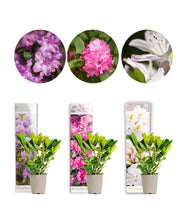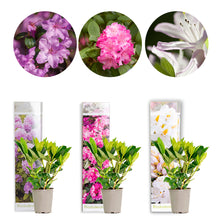Rhododendron (from Ancient Greek ῥόδον rhódon "rose" and δένδρον déndron "tree") is a large and diverse genus of flowering plants, with over 1,000 species and countless cultivars. They are known for their beautiful and often showy flowers, which come in a wide range of colors, including pink, purple, red, white, and yellow. Rhododendrons are popular ornamental shrubs in gardens and landscapes around the world, and many are well-suited to growing in pots or containers. They belong to the Ericaceae family.
Light: Rhododendrons generally prefer partial shade, especially during the hottest part of the day. Morning sun and dappled shade are ideal. Some varieties can tolerate more sun, but it's important to protect them from intense afternoon sun, which can scorch the leaves.
Water: Rhododendrons prefer consistently moist, but not waterlogged, soil. Water thoroughly when the top inch or two of soil feels dry to the touch. Avoid letting the soil dry out completely, as this can stress the plant. It's also important to avoid overwatering, which can lead to root rot.
Soil: Rhododendrons require acidic soil with a pH between 4.5 and 6.0. They thrive in loose, well-draining soil that is rich in organic matter. You can amend the soil with ericaceous compost or peat moss to increase acidity and improve drainage.
Fertilising: Feed your Rhododendrons with a fertiliser specifically formulated for ericaceous plants. Apply the fertiliser in spring and early summer, following the instructions on the product label. Avoid over-fertilising, as this can damage the roots.
Temperature: Rhododendrons are generally hardy shrubs that can tolerate a range of temperatures, but they prefer cool to moderate climates. They are not tolerant of extreme heat or prolonged periods of freezing temperatures.
Pruning: Rhododendrons don't require extensive pruning, but you can deadhead spent flowers and prune lightly to shape the plant after flowering. Avoid heavy pruning, as this can reduce flowering.
Toxicity: Many Rhododendron species contain toxins called grayanotoxins, which can be harmful if ingested by humans and animals. It's best to keep them away from children and pets.



